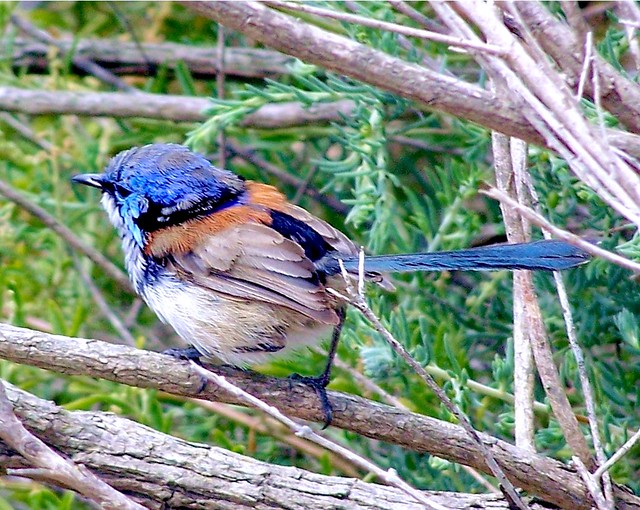Malurus pulcherrimus Cladus: Eukaryota Name Malurus pulcherrimus Gould, 1844 Reference Proceedings of the Zoological Society of London Pt12 no.136 p.106 Vernacular names The Blue-breasted Fairywren (Malurus pulcherrimus) is a species of bird in the Maluridae family. It is endemic to Australia. The range of the Blue-breasted Wren is inland south-western Western Australia and the Eyre Peninsula of South Australia. Originally it was thought to only occur in Western Australia, but was later found in the more eastward area, where it was for sometime mistaken for one of the many forms of the Variegated Wren, Malurus lamberti. The distribution of the species is unusual in that there is a gap in their range of three hundred kilometres; from the head of the Great Australian Bight to their reappearance on Eyre Peninsula. It is not a common species, and being secretive by nature it is not an easy bird to observe. However, the females may be induced to show themselves if the wren distress call is imitated. The adult males are even more shy than the females and are usually only glimpsed skulking in the bushes. Blue-breasted Wrens are predominately ground feeders, taking beetles, grubs, ants, weevils flies, wasps and other small invertebrates. The contact call is a soft, short reed-like trill. The alarm call is the typical malurus short churring notes repeatedly spat out and taken up by all members of the group. The males have the least distinctive song of the malurus family. It being a soft whirring, buzzing trill, usually given from a sheltered vantage point deep within the foliage of shrubby vegetation. The comparatively short breeding season is from August to November. This means the species usually only has time to raise one, sometimes two, clutches per year. Only females have been observed nest building, and brooding the eggs and young. The time taken to complete a nest is roughly a week. The average clutch consists of three ovoid creamy eggs speckled with coarse smudges and blotches of reddish-brown, particularly on the larger end. Little is known of the incubation period and the rearing of the young, but these tasks are probably similar in nature to the other closely related members of the wren family. However, both parents, and other members of the individual family group, have been observed feeding the nestlings. If the nest, or young, are threatened both adult sexes employ the “rodent-run” predator distracting technique typical of the Maluridae. References * BirdLife International 2004. Malurus pulcherrimus. 2006 IUCN Red List of Threatened Species. Downloaded on 26 July 2007. * Chilton, Richard V. Bird Keeping in Australia Vol. 53 No. 7 July 2010 The Malurus Genus, #3 The Blue-breasted Wren Source: Wikipedia, Wikispecies: All text is available under the terms of the GNU Free Documentation License |
|

